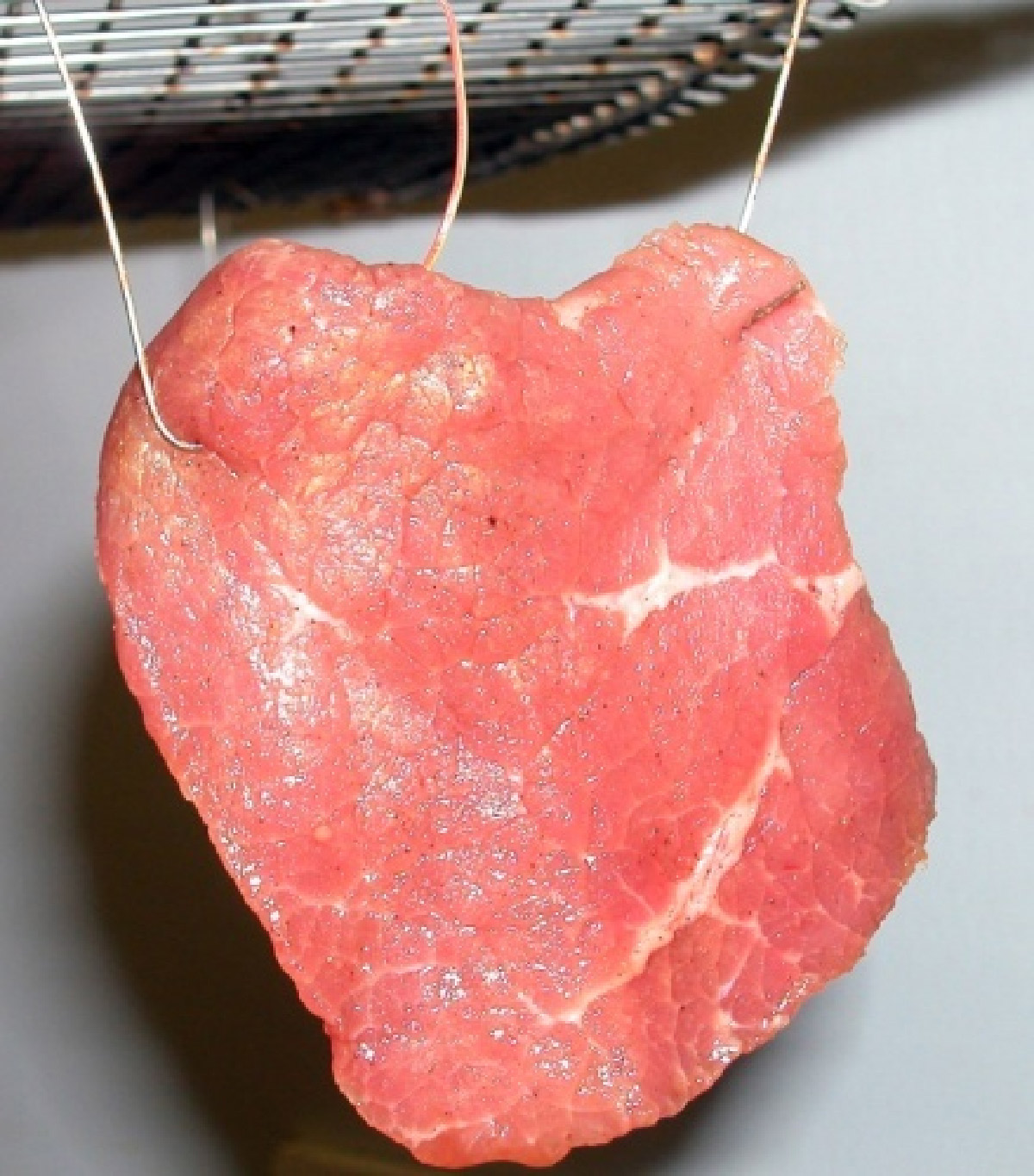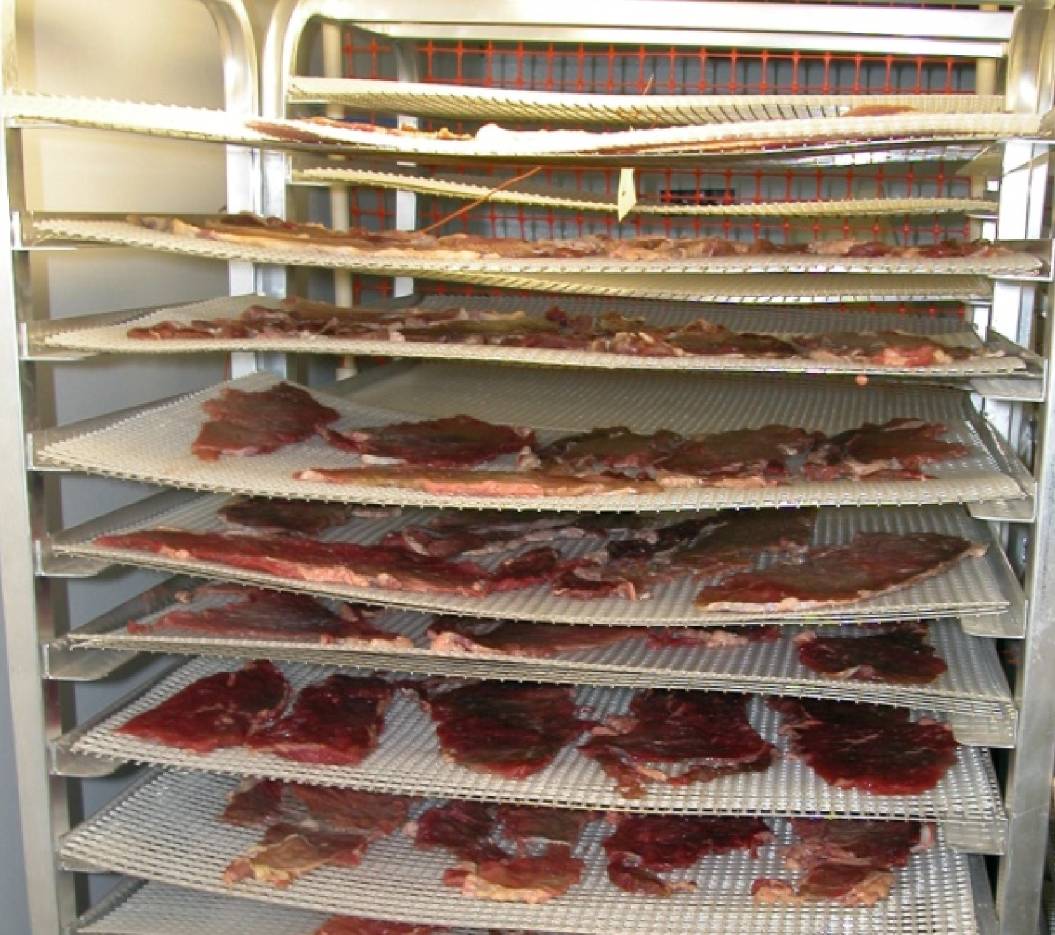Reduction of Drying Time for Jerky Products
Jerky manufacturing is a time-consuming process because meat must be dried slowly at a relatively low temperature. Dehydration time varies from processor to processor and depends on many variables such as dehydrator temperature setting, humidity control, jerky slice thickness and equipment configuration. Some dehydration cycles that include a lethality step take more than 12 hours. Processors may be able to reduce production costs and increase product throughput by reducing dehydration times. The objective of this fact sheet is to report on three factors that have been identified and proven to reduce dehydration time without drastically affecting the final product (Bowser, et al. 2009).
Three Factors That Can Reduce Jerky Drying Time
The three factors that can reduce drying time are (in order of importance):
- Chemical tenderization
- pH
- Product orientation
Tenderization helps to break down the fibers of the meat product creating more avenues for moisture to escape during the dehydration process. Many tenderizers will probably work, but Bowser et al. (2009) used a liquid papain product (Liquipanol T-100, Enzyme Development Corp., New York) that was applied at the rate of 1 mg of tenderizer per pound of meat. The tenderizer was added to the marinade and the jerky was allowed to sit for 1 hour at 40˚F. All of the marinade was soaked up by the jerky.
Adjustment of raw product pH may help dehydrate the meat more rapidly because of a unique physical property called the isoelectric point. The isoelectric point is the pH value (5.2) at which meat products hold the least amount of moisture. A small amount of vinegar was added to the marinade to adjust the pH to the isoelectric point.
Orientation of product may have a significant effect on dehydration time. Research results indicate that vertical orientation is the best. Products with a vertical orientation may dry faster because free water runs off the surface, rather than accumulating on a horizontal surface. This is especially important during high-humidity pasteurization processes that many jerky manufacturers are now using. Most jerky can be hung vertically by hooks, draped across supports or pierced by and hung on a support. Restructured jerky products do not permit handling prior to dehydration and must be oriented horizontally and fully supported by trays.
Virtually any processer will be able to test one or more of the factors to speed up their manufacturing process. The three factors are fairly simple to implement – but some might be inappropriate for a specific product and production process used by a given manufacturer. For instance, orientation does not make sense if the product cannot be physically manipulated into a vertical position (e.g. extruded jerky) or if vertical placement results in unacceptable cosmetic changes in the final product. Tenderizer might not be an acceptable ingredient in an organic, natural, premium product.
Five Steps to Reduce Jerky Drying Time
Reducing drying time can add dollars directly to the profit of your operation by reducing the cost of energy and increasing product throughput. Five steps to take to reduce jerky drying time are:
- Analyze the drying process and equipment. Develop an understanding of the following:
- Requirements for processing and materials handling.
- Product attributes.
- Type of equipment.
- Product/process safety.
- Identify the factors (tenderizer, pH and orientation) that can be successfully applied to the product without upsetting the production system or negatively affecting the final product.
- Implement the factors identified in step 2.
- Track results.
- Adjust factors and production system to make continuous improvements.
The five steps are described further below.
1. Analyze the Drying Process and Equipment
A solid understanding of the drying process and equipment is needed.
- How is the meat treated prior to dehydration? Can any of the factors (e.g. tenderizer and pH adjustment) be added during the marinade or mixing process without extra work?
- Will the final product be negatively affected by the addition of tenderizer or an acid? Can the product be dried in a vertical orientation without negatively affecting the final appearance and feel of the product?
- Will the equipment accommodate process changes to add liquids to adjust pH or a tenderizer? Can the product be supported in a vertical orientation without sacrificing capacity and increasing preparation time?
2. Identify the Factors that Successfully Can Be Applied to Your Product
Based on an analysis of the drying process and equipment, which factor(s) can be applied to the dehydration process? Tenderization can change product texture, which may affect physical properties like tear strength and mouth-feel. Changes can be viewed positively or negatively. Tenderizer may permit the use of a less expensive grade of meat that was previously rejected because of toughness. Adjustment of pH may result in some flavor change; but other ingredients could be added to offset acid tartness and improve final flavor. Bromelain (a tenderizer) is an example of a potential ingredient that may be classified as a nutraceutical that promotes joint health; therefore, increasing the appeal of the final product for a target audience (any label statement would require supporting evidence). Also, the ingredient statement must be considered when identifying factors, since the tenderizer, acidifier and any additional ingredients must be included on the label.
3. Implement the Factors Selected
Put the new ideas to work by trying them out in a limited production run or in a portion of a production run. Experimentation does not need to be expensive and risky. Try new factors on a single tray or rack of product; using the natural divisions within your process equipment (e.g shelves) to subdivide the treatment.
4. Track Results
Keep careful records of everything done to modify the product and compare results to the standard. If the dehydration time of the standard product is not well documented, this activity must be undertaken as well. Overall drying times should decrease significantly and permanently because of the treatment(s).
5. Make Continuous Improvements
The activity of recording the results of the dehydration processes will help to identify areas of improvement or to determine if something has changed. When changes have occurred, the five-step process can be reiterated to solve new problems. The process of making incremental changes for the best is called “continuous improvement.” Data collected should include (but is not limited to): date, drying time, product identification, operator, yield, outdoor conditions (temperature and relative humidity) and any unusual observations (e.g. non uniform drying, special weather conditions like hail or sleet, power failures and personnel changes). Use continuous improvement activities to look for patterns that might show cause and effect, like propped open doors in the processing room that allow more fresh air to enter into the dehydrator, reducing drying time.
Figure 1. Beef jerky hanging in a dehydrator from two wire hooks (thermocouple wire is visible in top center of photo).
Food Safety
Dehydrators often are used to achieve a critical control point (CCP) for food safety. A reduction in dehydration time should not affect food safety of jerky products as long as an approved lethality step is included in the dehydration process. See fact sheet FAPC-165 Consistent Lethality Treatment for Small-Scale Jerky Dehydrators for additional information on this topic.
Figure 2. Beef jerky slices on horizontal racks in a dehydrator.
Conclusion
As energy, labor and equipment prices continue to rapidly increase; the efficiency of a jerky dehydration system is becoming more important. Reducing jerky drying time can result in increased cash flow and improved product quality. Modifications in the process and final product may be needed, but when properly implemented, changes will be classified as improvements.
References
Bowser, T.J., R.S. Frazier, P.R. Weckler, S.J. Kowalski. 2009. Optimizing jerky drying time with minimal product impact. submitted to The Open Food Science Journal, Bentham Science Publications, www.bentham.org/open/index.htm
Timothy J. Bowser
FAPC Food Process Engineer
Jacob Nelson
FAPC Value-Added Meat Processing Specialist
Stacey J. Kowalski
FAPC Research Assistant


